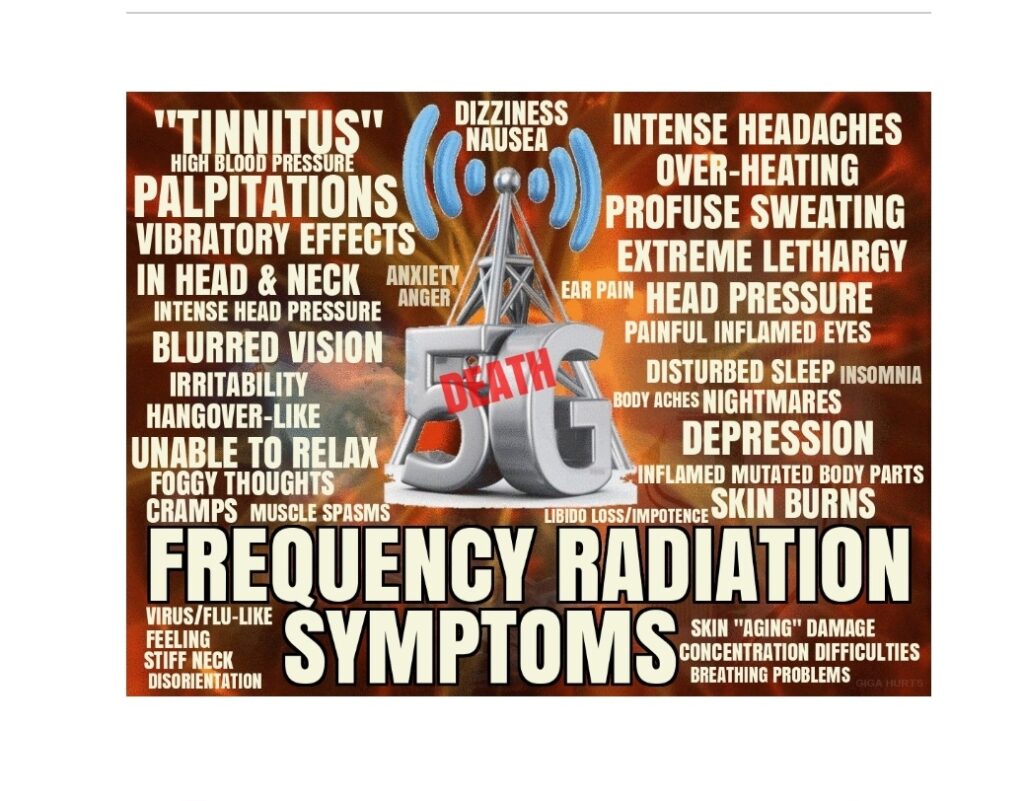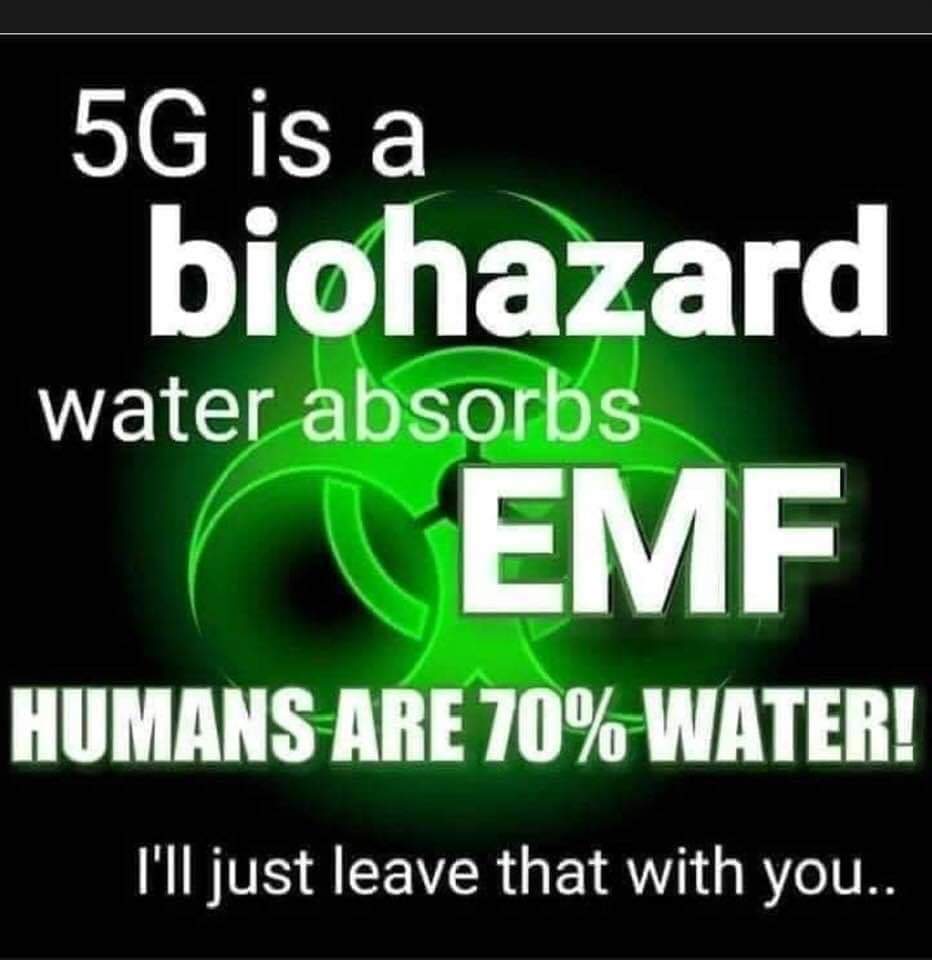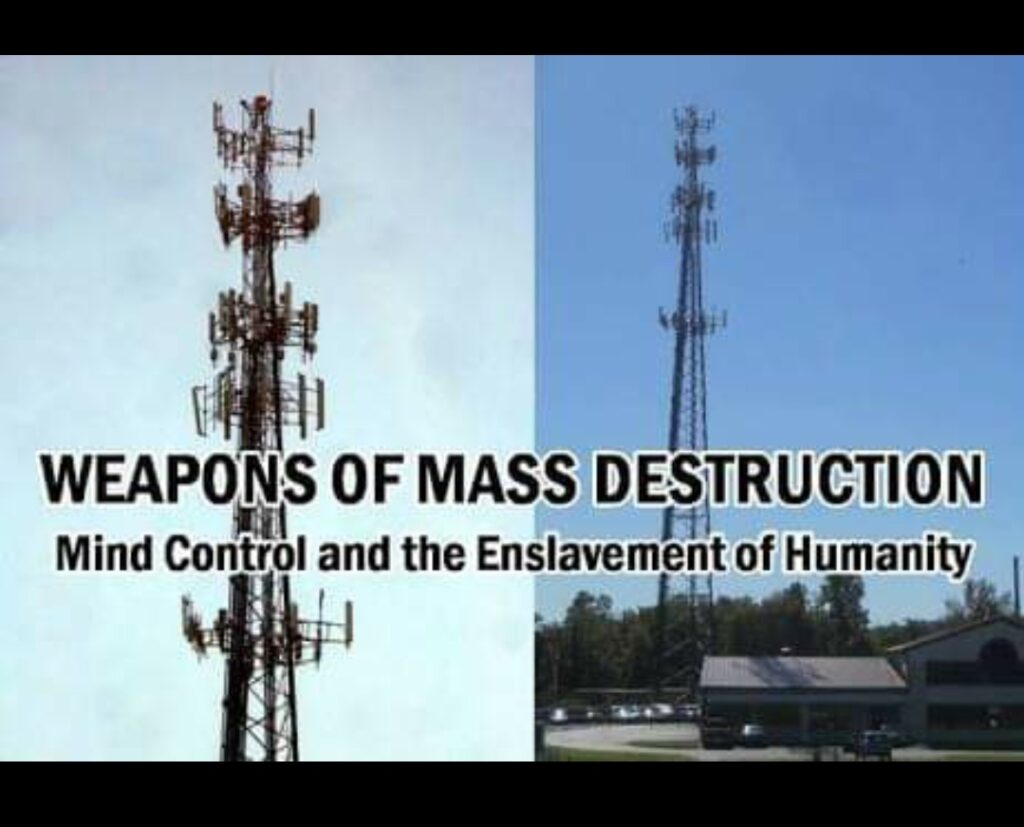
The 5G system is a wireless network that operates in the 60GHz spectrum with download speeds of up to 10 Gbps compared to the 4G download speed of 10 Mbps. However, the frequency of 60 GHz is the frequency at which oxygen molecules oscillate. At 60 GHz, 98% of the transmitted 5G energy will be absorbed by atmospheric oxygen which then alters the orbital properties of the electrons of the oxygen molecules. “60GHz is the frequency of oxygen molecule absorption. Oxygen molecules have electrons that they share with each other, oxygen is a diatomic molecule. What we breathe are two oxygen molecules bonded together with the electrons that they share.” When the oxygen molecule is hit with 60GHz 5G waves, these waves affect the orbital resonance properties of those shared electrons. It is those shared electrons that bind to the hemoglobin in our blood.

When the oxygen is disrupted, it will no longer bind to the hemoglobin and myoglobin (oxygen carrying molecules) and therefore will not be able to carry oxygen to the cell’s powerhouse ‘mitochondria’. Without oxygen, the liver becomes congested and the body, and brain, begins to break down due to slow suffocation. Because the brain is the body organ most sensitive to the lack of oxygen, not getting enough oxygen to the brain will result in brain hypoxia. Brain hypoxia symptoms range from mild to severe. Mild symptoms include: cognitive disturbances, temporary memory loss, reduced ability to move your body, difficulty paying attention, difficulty making sound decisions. Severe symptoms include: fainting, seizure, coma, brain death.

The spectrum for 4G starts from 700 MHz to 5 GHz frequency bands. Compared to the frequencies below 5 GHz previously used by mobile devices, millimeter wave technology allows transmission on frequencies between 30 GHz and 300 GHz. These frequencies are called millimeter waves because they have wavelengths between 1 mm and 10 mm, while the wavelengths of the radio waves currently used by smartphones are mostly several dozen centimeters.
Health Effects of cumulative low intensity Radio Frequency radiation exposure include: DNA mutations, Mitochondrial damage, Tumors, cancer (children’s skulls receive more radiation) Heart palpitations, Memory and cognitive problems, Sperm changes and infertility, Headaches, migraines, ringing of ears, ADHD ,Anxiety Depression Heart and Disease Type-2 Diabetes

Radiofrequency/microwave (RF/MW) radiation affect the Schumann Resonance signals which are the mechanism through which melatonin production is activated. The frequencies also affect the bodies ability to produce Vitamin D (Vitamin D deficiency causes cold and flu due to the weakening of the immune system. This is the reason why people are prone to cold and flu in the winter season).
The electromagnetic radiation in the microwave frequency range ‘are absorbed by water, fats, sugars, and certain other molecules, whose consequent vibrations produce *heat*.’ Similar to microwave ovens which generate radiation at a frequency of about 2.45GHz (the microwave energy is converted to thermal energy by causing water molecules to flip back and forth some 2.45 billion times a second…The 60 GHz used by the 5G system causes water molecules to flip back and forth 60 billion times a second!!!)
The latest cellular technology, 5G, will employ millimeter waves for the first time in addition to microwaves that have been in use for older cellular technologies, 2G through 4G. Given limited reach, 5G will require cell antennas every 100 to 200 meters, exposing many people to millimeter wave radiation. 5G also employs new technologies (e.g., active antennas capable of beam-forming; phased arrays; massive multiple inputs and outputs, known as massive MIMO) which pose unique challenges for measuring exposures.
The World Health Organization’s International Agency for Research on Cancer (IARC) classified RFR as “possibly carcinogenic to humans” in 2011. Last year, a $30 million study conducted by the U.S. National Toxicology Program (NTP) found “clear evidence” that two years of exposure to cell phone RFR increased cancer in male rats and damaged DNA in rats and mice of both sexes. The Ramazzini Institute in Italy replicated the key finding of the NTP using a different carrier frequency and much weaker exposure to cell phone radiation over the life of the rats
The telecommunications industry and their experts have accused many scientists who have researched the effects of cell phone radiation of “fear mongering” over the advent of wireless technology’s 5G.
Cancer epidemiology update, following the 2011 IARC evaluation of radiofrequency electromagnetic fields is a comprehensive research review of RF effects in human and animal research. The review concludes that scientific evidence is now adequate to conclude radiofrequency radiation is carcinogenic to humans (Miller 2018). Several previously published studies also concluded that RF can “cause” cancer, for example, Hardell 2017, Atzman 2016 and Peleg 2018.
Published Research Documents Adverse Effects of RF Exposure
The Ramazzini Institute (RI) Study on Base Station RF was another large scale rat study that also found increases in the same heart cancers as the NTP study found—yet the Ramazzini rats were exposed to much lower levels of RF than the NTP rats. In fact, all the RI Ramazzini radiation exposures were below FCC limits, as the study was specifically designed to test the safety of RF limits for cell tower/base stations (Falconi 2018.)
Tumor promotion by exposure to radiofrequency electromagnetic fields below exposure limits for humans” is a replication study that used very, very low RF exposures (lower than the Ramazzini and NTP study) and combined the RF with a known carcinogen. Researchers found elevated lymphoma and significantly higher numbers of tumors in the lungs and livers in the animals exposed to both RF and the carcinogen, leading researchers to state that previous research (Tillman 2010) was confirmed and that “our results show that electromagnetic fields obviously enhance the growth of tumors” (Lerchl 2015).
5G Wireless Expansion: Public Health and Environmental Implications is a 5G research review that documents the range of reported adverse effects of RF and millimeter waves—effects range from cancer to bacteria growth changes to DNA damage. The study concludes that “a moratorium on the deployment of 5G is warranted” and “the addition of this added high frequency 5G radiation to an already complex mix of lower frequencies, will contribute to a negative public health outcome … from both physical and mental health perspectives” (Russell 2018).
“The Human Skin as a Sub-THz Receiver – Does 5G Pose a Danger to It or Not?” and “The Modeling of the Absorbance of Sub-THz Radiation by Human Skin” are two papers by physicists presenting research that found higher 5G frequencies are intensely absorbed into human sweat ducts (in skin), at much higher absorption levels than other parts of our skin’s tissues (Betzalel 2017, Betzalel 2018). The researchers conclude, “we are raising a warning flag against the unrestricted use of sub-THz technologies for communication, before the possible consequences for public health are explored.”
“Exposure of Insects to Radio-Frequency Electromagnetic Fields from 2 to 120 GHz” published in Scientific Reports is the first study to investigate how insects (including the Western honeybee) absorb the higher frequencies (2 GHz to 120 GHz) to be used in the 4G/5G rollout. The scientific simulations showed increases in absorbed power between 3% to 370% when the insects were exposed to the frequencies. Researchers concluded, “This could lead to changes in insect behaviour, physiology, and morphology over time….”
“A review of the ecological effects of RF-EMF” reviewed 113 studies finding RF-EMF had a significant effect on birds, insects, other vertebrates, other organisms and plants in 70% of the studies (Cucurachi 2013). Development and reproduction in birds and insects were the most strongly affected. As an example of the several studies on wildlife impacts, a study focusing on RF from antennas found increased sperm abnormalities in mice exposed to RF from GSM antennas (Otitoloju 2010). Studies on bees have found behavioral effects (Kumar 2011, Favre 2011), disrupted navigation Goldsworthy 2009, Sainudeen 2011, Kimmel et al. 2007) decreasing egg laying rate (Sharma and Kumar, 2010) and reduced colony strength (Sharma and Kumar, 2010, Harst et al. 2006). Research has also found a high level of damage to trees from antenna radiation (Waldmann-Selsam 2016).
“Towards 5G communication systems: Are there health implications?” is a research review that details how research has found that millimeter waves can alter gene expression, promote cellular proliferation and synthesis of proteins linked with oxidative stress, inflammatory and metabolic processes.” The researchers conclude, “available findings seem sufficient to demonstrate the existence of biomedical effects, to invoke the precautionary principle” (Di Ciaula 2018).
Research on People Near Cell Towers Links Exposure to Adverse Effects
“The Impact of radiofrequency radiation on DNA damage and antioxidants in peripheral blood lymphocytes of humans residing in the vicinity of mobile phone base station” is a research study that compared people living close (within 80 meters) and far (more than 300 meters away) from cellular antennas and found that the people living closer had several significant changes in their blood predictive of cancer development (Zothansiama 2017). Researchers controlled for various demographics, including the use of microwaves and wireless in the homes.
“Mortality by neoplasia and cellular telephone base stations” is a 10 year study by the Belo Horizonte Brazil Health Department and several universities in Brazil that found an elevated relative risk of cancer mortality at residential distances of 500 meters or less from cell installations (Dode 2011). Shortly after this study was published, the city prosecutor sued several cell phone companies and requested that almost half of the city’s antennas be removed. Many antennas were dismantled.
A 2019 study of students in schools near cell towers found their higher RF exposure was associated with impacts on motor skills, memory and attention (Meo 2019). Examples of other effects linked to cell towers in research studies include neuropsychiatric problems, elevated diabetes, headaches, sleep problems and genetic damage. Such research continues to accumulate after the 2010 landmark review study on 56 studies that reported biological effects found at very low intensities, including impacts on reproduction, permeability of the blood-brain barrier, behavior, cellular and metabolic changes, and increases in cancer risk (Lai and Levitt 2010).
Cellular Antennas Create Measurable Increases in Radiation in the Area
A 2018 article published in The Lancet Planetary Health points to unprecedented increasing RF exposures (Bandara and Carpenter 2018). Another key finding from Zothansiama 2017 was that homes closer to antennas had measurably higher radiation levels—adding to the documentation that antennas increase RF levels. An Australian study also found that children in kindergartens with nearby antenna installations had nearly three-and-a-half times higher RF exposures than children with installations further away (more than 300 meters (Bhatt 2016).
A 2018 multi-country study that measured RF in several countries found that cell phone tower radiation is the dominant contributor to RF exposure in most outdoor areas exposure in urban areas was higher and that exposure has drastically increased. As an example, the measurements the researchers took in Los Angeles, USA were 70 times higher than the US EPA estimate 40 years ago.
Two recent papers that have investigated frequencies to be used in 5G have called out the need to reevaluate current guidelines due to the unique way higher frequencies interact with human tissue. These studies are clear documentation of the reality that 5G technology is being rolled out before adequate research on human exposures. “Systematic Derivation of Safety Limits for Time-Varying 5G Radiofrequency Exposure Based on Analytical Models and Thermal Dose concludes that the “results also show that the peak-to-average ratio of 1,000 tolerated by the International Council on Non-Ionizing Radiation Protection guidelines may lead to permanent tissue damage after even short exposures, highlighting the importance of revisiting existing exposure guidelines.” “Human Exposure to RF Fields in 5G Downlink concludes “our results show that 5G downlink RF fields generate significantly higher power density (PD) and specific absorption rate (SAR) than a current cellular system. This paper also shows that SAR should also be taken into account for determining human RF exposure in the mmW downlink.”
Note: This is just a small sampling of research on radio frequency microwave radiation. EHT has more research on millimeter waves and 4/5G here.
For more please see:
- The Bioinitiative Report: An extensive report authored by international scientists published in the field of EMF’s calling for the reform of outdated safety standards due to the mounting evidence of health effects from electromagnetic fields (1479 pages of scientific evidence).
- Research Abstracts: These are invaluable sets of abstracts (data-based to be searchable) covering the RFR scientific literature, as well as collections of scientific abstracts on free radical damage (from both RFR and ELF) and a set specific to electrosensitivity. They cover the research published between 1990-2014.
- Color Charts at Exposure Levels: These invaluable charts detail the published science showing biological effects at different exposure levels. We highly recommend that you take the time to review them.
- Annotated Bibliography of Scientific Papers Finding Evidence of Harm from Cell Phone Radiation Exposure Published between August, 2016 and July, 2018 Joel M. Moskowitz, Ph.D. School of Public Health University of California, Berkeley which contains 92 papers published in scientific journals during the last two years that report evidence of harm from cell phone radiation exposure.
- PowerWatch: 1,670 Peer-Reviewed Scientific Papers on Electromagnetic Fields and Biology or Health
- “5G: Great risk for EU, U.S. and International Health! Compelling Evidence for Eight Distinct Types of Great Harm Caused by Electromagnetic Field (EMF) Exposures and the Mechanism that Causes Them” by Dr. Martin Pall
- The Oceania Radiofrequency Science Advisory Association: The Oceania Radiofrequency Science Advisory Association (ORSAA) Database is a searchable database on peer-reviewed scientific studies and articles on bioeffect research of electromagnetic fields. The database is designed to enable detailed independent searches invaluable to researchers and scientists. It requires some training on how to use it most effectively.
- Dr. Joel Moskowitz of UC Berkeley maintains a blog of research studies and policy updates here.